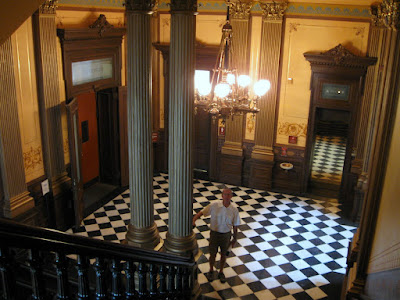A couple weeks ago, on July 23rd, Dar and I made a visit to Lansing and the Michigan State Capitol Building. We've been making it a point to visit capitols when we're camped close by, and this visit will make Michigan our 15th. I reported this exploration in the Journal for that day, but said I'd do a more thorough post at a later date. This is that post.
Michigan was part of the Northwest Territory established by the US Congress in 1787 and was made it's own territory, the Michigan Territory, in 1805. Michigan began applying for statehood as early as 1832 but was rebuffed due to a dispute with Ohio (already a State) over a strip of land called the Toledo Strip, a sliver of land that ran just south of the current border and included the City of Toledo, an important shipping port on Lake Erie. By 1835 Michigan formed a State Government without authorization by Congress and included the Toledo Strip in it's jurisdiction. A bloodless conflict, called the Toledo War, erupted between Ohio and Michigan that same year. In dire financial straits due to the conflict and the resulting lack of statehood, Michigan finally "surrendered" the Toledo Strip to Ohio, and was granted statehood in 1837. As a consolation prize, Michigan was granted rights to the western 3/4 of the Upper Peninsula, which otherwise might have been given to Wisconsin.
Detroit was the first Capital of the new state but concerns about the defensibility of a Capitol building such a short distance from the Canadian border (Detroit was occupied by the British during the war of 1812) and with an interest in encouraging western development of the State, the nearly uninhabited Lansing Township was named the new Capital in 1847. That same year, a temporary wooden building was quickly erected to the the Capitol.
The Civil War caused any consideration of a new, more permanent, Capitol to be delayed until the 1870's. In 1872 Elijah E. Myers of Springfield IL was selected as architect and construction began in 1873. Taking 6 years to complete, the building was dedicated on January 1, 1879.
The building is laid out in a fashion similar to the United States Capitol, with a central dome and rotunda, and the branches of government occupying the wings. This style became a common one for many of the subsequent Capitol buildings that followed. Myers went on to also design the Capitols of Colorado and Texas, and the territorial Capitol of Idaho -- the most of any other single architect.
Like many other statehouses over the years, the building itself wasn't a high priority for the growing State and it fell into disrepair and neglect. But between 1989 and 1992 an extensive historical restoration project restored the building to it's original grandeur.
Our first impression was positive... this looks like a Capitol should look. And that positive impression held throughout our visit. The grounds are neat and clean, the building is nicely appointed, with about the right amount of symbolism communicated through art. Portraits of former governors and notable people from Michigan are present. The restoration project was clearly well done, and, based on descriptions from our tour guide, was clearly necessary. It is also fortunate the restoration was done when it was -- during a period of relative affluence for the State. If it had been delayed 10 years, and with all the economic hits the State has taken since 2001, there's little chance it would have been done at all.
Ranking right up there in the top third of Capitols we've visited, the Michigan State Capitol was a sensory pleasure and an intellectual delight.
See these and other photos from our day at the Capitol in our Online Photo Album.





Nice write up. Your articles and photography just keep getting better and better.
ReplyDeletesh
Aw, shucks... Thanks Shirleen.
ReplyDelete